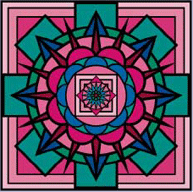
Mandalas are often used in meditation and to symbolize our center, wholeness of self, the universe and its spiraling energies, and our connections to the community. They can also represent the search for our personal center.
In mathematics, a circle is defined by its center and would not exist without it. Mandala has also become a generic term for any plan, chart or geometric pattern which represents the cosmos metaphysically or symbolically: a microcosm of the universe from the human perspective. It is a pattern found in nature and seen in biology, geology, chemistry, physics and astronomy.
Examples of mandalas found in nature include sunflower, lotus flowers, (actually, most flowers), sun, earth, full moon, snowflake, spider web, and the spiraling inward and outward of a snail's shell. Mandalas are also found in art and architecture all over the world. A labyrinth is a type of mandala found in many cultures and used as a tool for centering. Traditionally, mandalas are geometric, but abstract, asymmetrical mandalas are becoming increasingly popular in the West.
Psychiatrist Carl Jung strongly believed in the therapy of painting and coloring mandalas to express ourselves and to find security in a center rather than becoming lost on the path of existence. Both Navajo Indians and Tibetan monks create sand mandalas to demonstrate the impermanence of life. According to the Dalai Lama, when the sand mandala is constructed, (a formal process which requires teams of five monks working 17 hour shifts and about four days to complete) something in the atmosphere changes and peace is created. It is thought that it creates a harmonic vibration with healing power. Art therapists and psychologists routinely observe that the circle plays a healing role in patients with life threatening diseases.
I discovered mandalas simply because I had always just been drawn to them. I didn't know they were called mandalas, or that they had any significance for anyone other than for their aesthetic qualities. When I was a child, my grandparents brought me some coloring books of intricate geometric patterns and I spent hours coloring them, creating symmetric patterns with color. When my daughter was old enough, I searched for and found books like that for her to color, and she loved them! Of course, it was also an excuse for me to color again!!!
I got into quilting about eight years ago and continued to be attracted to these types of patterns that emanate from a center point. One day a couple of years ago, I was in a book store and was intrigued by a book with with a colorful, circular design on the cover. Its title included the word mandala. I opened it and saw that it contained interesting black and white designs, which could be colored or reproduced in larger form. The book explained where the particular designs came from and their significance, but I was mostly interested in their artistic value. I wanted to use them as a basis for quilt patterns.
Because I found designing and coloring mandalas to be fun and relaxing, I started to do some research on their significance. I was surprised to learn that the designs I admired had this much history and importance in so many cultures!


